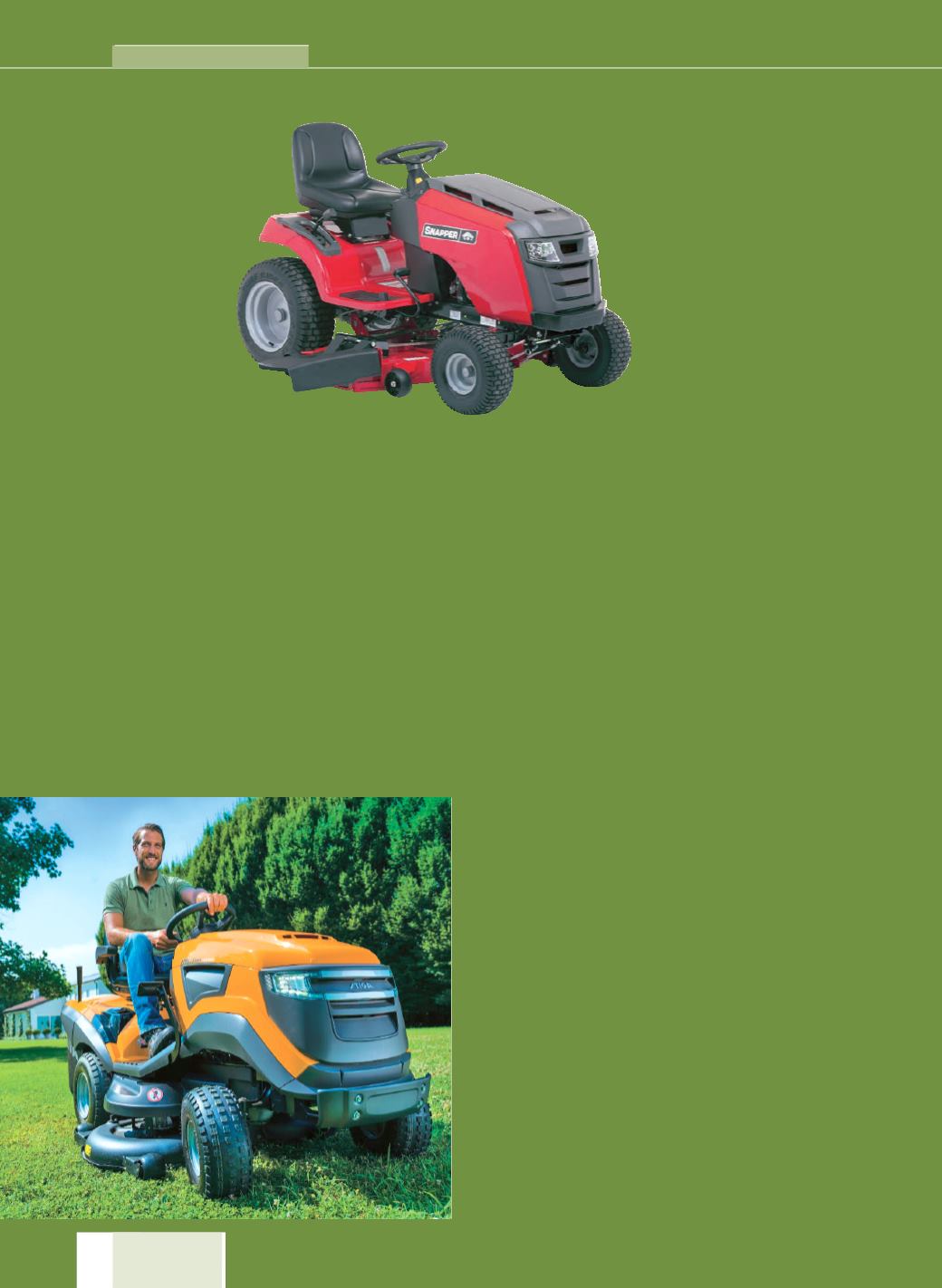
Trattorini
I trattorini rasaerba, nella termino-
logiaanglosassone lawn tractor,so-
nomacchine con conducenteabor-
do, conmotore posto anteriormen-
te al conducente e apparato di
taglio a lame orizzontali in po-
sizione ventrale. In origine
erano derivati dai trattori
agricoli di piccola potenza
a cui sonostati applicati il
piatto di taglio in posizio-
ne ventrale e pneumatici
garden. In seguito lamac-
china si è evoluta divenen-
dosemprepiù rispondenteal
taglio del tappeto erboso.
L’unità motrice poggia su un assale posteriore con
ruote motrici e un assale anteriore con ruote direttrici. Sono
equipaggiati conmotori a ciclo Diesel o a scoppio, con poten-
za, in funzione della larghezza di lavoro, da 6-10 kW a 20-25
kW. Nella versione con cesto di raccolta dell’erba tagliata si ri-
corre, quando il cesto supera certi volumi, anche alla zavorra-
tura anteriore. Per questa tipologia di rasaerba il peso della
macchina è pressoché uniformemente ripartito tra l’assale an-
teriore e quello posteriore, per cui ciascuna ruota esercita sul
tappeto pressoché la stessa pressione. Inoltre, essendo l’ap-
parato di taglio in posizione ventrale, l’erba viene piegata pri-
ma di essere tagliata, conferendo irregolarità al tappeto rasa-
to. Il fatto poi di avere il motore in posizione frontale riduce la
visibilità del conducente con possibile ripercussione sulla pre-
cisionedel lavoro. Nellageneralitàdei casi lamanovrabilitàdel-
lamacchina non èmolto grande. Questo rappresenta un impe-
dimento quando si deve operare su tappeti irregolari con pre-
senze di alberi, arbusti e aiuole. Vengono però realizzati anche
modelli con raggio di sterzata ridotto, per i quali al momento
dellasterzata la ruotaposteriore interna va in folleevitando co-
sì di danneggiare la cotica erbosa. In termini generali si può af-
fermarechequesta tipologiadi rasaerbanonè lapiùadattaper tap-
lawn.
The power unit is based on a rear axle with drive wheels and a
front axle with steerable wheels. They are equipped with Diesel
cycle or combustion engines, with powers ranging from 6-10
kW to20-25kWdependingon theworkingwidth. In the
versionwith a bagger for the cut grass,when the
basket exceeds certain volumes,a front ballast
isalsoused. For this typeofmower, theweight
of themachine isalmost evenly distributedbe-
tween the front axle and the rear, so each
wheel exertsalmost the samepressureon the
turf. Furthermore, since the cutting appa-
ratus isunderneath, thegrass isbent be-
fore being cut, causing irregularities to
the mowed lawn. The fact of having the
enginepositioned in the front reduces vis-
ibility for the driver, with a possible impact
on accuracy. Inmost cases, themachine is not verymanoeu-
vrable. This is an impediment when onemust operate on lawns
with irregular layouts of trees, shrubs and flower beds.
There are alsomodelswitha small turning radius.Upon turning,
the inside rear wheel is disengaged, thus preventing damage to
the turf.
In general terms, it could be said that this type of lawnmower is
not themost suitable for quality turfs, and it should be taken in-
to account for surfaces exceeding 2000m
2
.
Types
Depending on the type of transmission, the distinction is between
models withmechanical transmission and thosewith hydrostatic
transmission. The first is found primarily onmachines with awork-
ingwidth of nomore than onemetre. Regardless of the transmis-
sion, themaximum forwardspeeddoesnotexceed9km/h.Theme-
chanical systemcanprovide5-7speedgears,while in thehydrosta-
tic one the speed variation is gradual and continuous,making the
driving easier and thework faster.Thereare twodifferent solutions
for thehydrostatic transmission.Theonewith foot controls isgener-
allypreferred,wherespeedanddirectionarecontrolledbyseparate
pedals for forwardand reverse.Theother solution is thehydrostatic
transmission controlledwitha leverwithin reachof thedriver.
The system to engage themowing can bemechanical (pulley-belt
system) or hydrostatic. In the hydrostatic version, the engagement
canbeperformedby theoperator bypressing thecommandbutton
of theelectromagneticclutchplacedon thedashboard.Thissystem
ensuresmorepreciseplacementof thebladesandnokickback.The
cuttingheight isadjustablebetween25and90mm,while thework-
ingwidthgoes from60-70 cm toabove130 cm.Dependingon the
workingwidth, cutting is performedby 1, 2 or 3 cutting blades.The
most frequent solutionhas twoasynchronousblades.
The cut grass canbeejected to the sideor to the rear. Inboth cas-
es thegrasscanbecollected inabagger.A thirdpossibility ismulch
cutting, which, as has beenmentioned, enables significant advan-
tages in termsofworking time. Indicatively it canbesaid thata lawn
tractorwithanenginepoweroutputof10-12kW,withacuttingwidth
of about 1metre, equippedwithabagger witha capacity of theor-
der of 300-350 litres, taking intoaccount the cuttingandgrassdis-
charge times, takes about one hour tomow2500-3000m
2
of turf.
By contrast,using the same tractor equipped formulch cutting, the
time ismore thanhalvedwithout doubling themowing frequency in
the courseof the year.
One quite frequent solution is to perform a collectionmow as the
first cut in springwhen thegrass is tall, thendoingmulchmowsaf-
ter that.Toallowmore versatility of themachinewhile leavingmaxi-
mum freedomof choiceon the typeof cut,manymodels,both side
dischargeand rear discharge, includeasstandardor asanoptiona
104
MW
n. 11/2015
IARDINAGGIO
G


